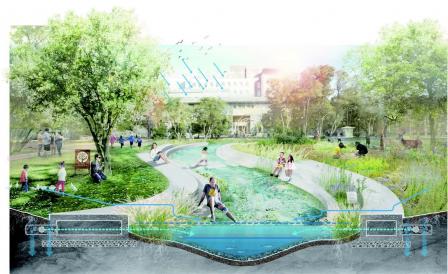
Challenge seeks to attract student interest from across the country
The U.S. Environmental Protection Agency (EPA) is launching its eighth annual Campus RainWorks Challenge, a design competition that is open to colleges and universities across the country. EPA seeks to engage with students to design innovative green infrastructure solutions for stormwater management, showcasing the environmental, economic, and social benefits of these practices.
“The Campus RainWorks Challenge gets students excited about innovative infrastructure that provides clean water for campus communities,” said EPA Assistant Administrator for Water David Ross. “The program engages the next generation of potential clean water professionals and fosters the interdisciplinary collaboration necessary to solve the problems of the future.”
The 2019 Campus RainWorks Challenge will foster a dialogue about the need for innovative stormwater management, asking interdisciplinary student teams to design creative green infrastructure solutions that address stormwater pollution and benefit the campus community. Teams may submit entries in two categories—demonstration projects or master planning.
Each first-place team will earn a student prize of $5,000 to be divided evenly among student team members and a faculty prize of $5,000 to support green infrastructure research or training. Second-place teams will win a $2,500 student prize and a $2,500 faculty prize.
Registration for the 2019 Challenge opened Sept. 1, 2019 and closes Oct. 15, 2019. Registrants must submit their entries by Dec. 17, 2019 and winners will be announced in the Spring 2020.
BACKGROUND:
Since 2012, nearly 700 teams and over 4,000 students have participated in the Campus RainWorks Challenge. Water pollution associated with stormwater runoff requires infrastructure solutions that are innovative, resilient and affordable. Green infrastructure refers to a variety of stormwater management practices that restore or mimic natural hydrological processes. While traditional stormwater infrastructure is largely designed to convey stormwater away from the built environment, green infrastructure uses soils, vegetation, and other media to manage stormwater where it falls.


Bulloch Public Safety
7/14/2025 Booking Report for Bulloch County

Chattooga Local Government
Congresswoman Marjorie Taylor Greene Introduces Bill to Eliminate Capital Gains Tax on Home Sales

Georgia News
‘Operation Southern Slow Down’ Starts Today

Bulloch Public Safety
06/23/2025 Booking Report for Bulloch County

Bulloch Public Safety
06/30/2025 Booking Report for Bulloch County

Bulloch Public Safety
06/16/2025 Booking Report for Bulloch County

Bulloch Public Safety
06/19/2025 Booking Report for Bulloch County

Bulloch Public Safety
7/09/2025 Booking Report for Bulloch County






